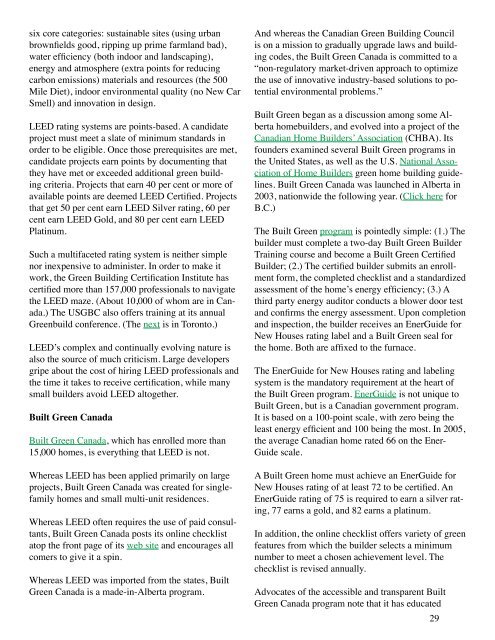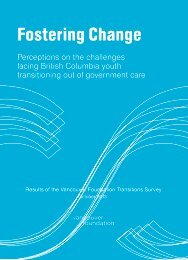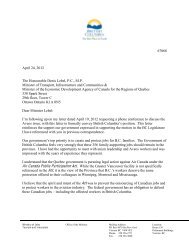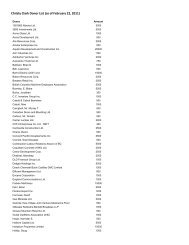from the ground up - The Tyee
from the ground up - The Tyee
from the ground up - The Tyee
Create successful ePaper yourself
Turn your PDF publications into a flip-book with our unique Google optimized e-Paper software.
six core categories: sustainable sites (using urbanbrownfields good, ripping <strong>up</strong> prime farmland bad),water efficiency (both indoor and landscaping),energy and atmosphere (extra points for reducingcarbon emissions) materials and resources (<strong>the</strong> 500Mile Diet), indoor environmental quality (no New CarSmell) and innovation in design.LEED rating systems are points-based. A candidateproject must meet a slate of minimum standards inorder to be eligible. Once those prerequisites are met,candidate projects earn points by documenting that<strong>the</strong>y have met or exceeded additional green buildingcriteria. Projects that earn 40 per cent or more ofavailable points are deemed LEED Certified. Projectsthat get 50 per cent earn LEED Silver rating, 60 percent earn LEED Gold, and 80 per cent earn LEEDPlatinum.Such a multifaceted rating system is nei<strong>the</strong>r simplenor inexpensive to administer. In order to make itwork, <strong>the</strong> Green Building Certification Institute hascertified more than 157,000 professionals to navigate<strong>the</strong> LEED maze. (About 10,000 of whom are in Canada.)<strong>The</strong> USGBC also offers training at its annualGreenbuild conference. (<strong>The</strong> next is in Toronto.)LEED’s complex and continually evolving nature isalso <strong>the</strong> source of much criticism. Large developersgripe about <strong>the</strong> cost of hiring LEED professionals and<strong>the</strong> time it takes to receive certification, while manysmall builders avoid LEED altoge<strong>the</strong>r.Built Green CanadaBuilt Green Canada, which has enrolled more than15,000 homes, is everything that LEED is not.Whereas LEED has been applied primarily on largeprojects, Built Green Canada was created for singlefamilyhomes and small multi-unit residences.Whereas LEED often requires <strong>the</strong> use of paid consultants,Built Green Canada posts its online checklistatop <strong>the</strong> front page of its web site and encourages allcomers to give it a spin.Whereas LEED was imported <strong>from</strong> <strong>the</strong> states, BuiltGreen Canada is a made-in-Alberta program.And whereas <strong>the</strong> Canadian Green Building Councilis on a mission to gradually <strong>up</strong>grade laws and buildingcodes, <strong>the</strong> Built Green Canada is committed to a“non-regulatory market-driven approach to optimize<strong>the</strong> use of innovative industry-based solutions to potentialenvironmental problems.”Built Green began as a discussion among some Albertahomebuilders, and evolved into a project of <strong>the</strong>Canadian Home Builders’ Association (CHBA). Itsfounders examined several Built Green programs in<strong>the</strong> United States, as well as <strong>the</strong> U.S. National Associationof Home Builders green home building guidelines.Built Green Canada was launched in Alberta in2003, nationwide <strong>the</strong> following year. (Click here forB.C.)<strong>The</strong> Built Green program is pointedly simple: (1.) <strong>The</strong>builder must complete a two-day Built Green BuilderTraining course and become a Built Green CertifiedBuilder; (2.) <strong>The</strong> certified builder submits an enrollmentform, <strong>the</strong> completed checklist and a standardizedassessment of <strong>the</strong> home’s energy efficiency; (3.) Athird party energy auditor conducts a blower door testand confirms <strong>the</strong> energy assessment. Upon completionand inspection, <strong>the</strong> builder receives an EnerGuide forNew Houses rating label and a Built Green seal for<strong>the</strong> home. Both are affixed to <strong>the</strong> furnace.<strong>The</strong> EnerGuide for New Houses rating and labelingsystem is <strong>the</strong> mandatory requirement at <strong>the</strong> heart of<strong>the</strong> Built Green program. EnerGuide is not unique toBuilt Green, but is a Canadian government program.It is based on a 100-point scale, with zero being <strong>the</strong>least energy efficient and 100 being <strong>the</strong> most. In 2005,<strong>the</strong> average Canadian home rated 66 on <strong>the</strong> Ener-Guide scale.A Built Green home must achieve an EnerGuide forNew Houses rating of at least 72 to be certified. AnEnerGuide rating of 75 is required to earn a silver rating,77 earns a gold, and 82 earns a platinum.In addition, <strong>the</strong> online checklist offers variety of greenfeatures <strong>from</strong> which <strong>the</strong> builder selects a minimumnumber to meet a chosen achievement level. <strong>The</strong>checklist is revised annually.Advocates of <strong>the</strong> accessible and transparent BuiltGreen Canada program note that it has educated29








